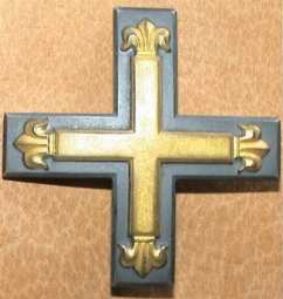
The history of Latvia began around 9000 BC with the end of the last glacial period in northern Europe. Ancient Baltic peoples arrived in the area during the second millennium BC, and four distinct tribal realms in Latvia's territory were identifiable towards the end of the first millennium AD. Latvia's principal river Daugava, was at the head of an important trade route from the Baltic region through Russia into southern Europe and the Middle East that was used by the Vikings and later Nordic and German traders.

The Baltic Germans are ethnic German inhabitants of the eastern shores of the Baltic Sea, in what today are Estonia and Latvia. Since their resettlement in 1939, Baltic Germans have markedly declined as a geographically determined ethnic group. It is estimated that several thousand still reside in Latvia and Estonia.
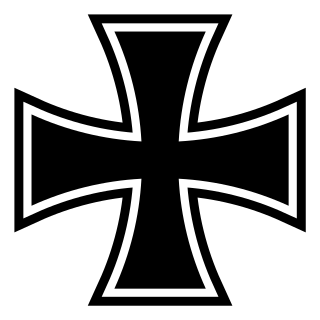
The Iron Cross was a military decoration in the Kingdom of Prussia, and later in the German Empire (1871–1918) and Nazi Germany (1933–1945). King Frederick William III of Prussia established it on 17 March 1813 during the Napoleonic Wars. The award was backdated to the birthday of his late wife, Queen Louise. Louise was the first person to receive this decoration (posthumously). The recommissioned Iron Cross was also awarded during the Franco-Prussian War, World War I, and World War II. The Iron Cross awarded during World War II has a swastika in the center. The Iron Cross was usually a military decoration only, though there were instances awarded to civilians for performing military functions, such as Hanna Reitsch, who received the Iron Cross 2nd Class and Iron Cross 1st Class, and Melitta Schenk Gräfin von Stauffenberg, who received the Iron Cross, 2nd Class, for being civilian test pilots during World War II.

The United Baltic Duchy, also known as the Grand Duchy of Livonia, was a state proposed by the Baltic German nobility and exiled Russian nobility after the Russian Revolution and German occupation of the Courland, Livonian, and Estonian governorates of the Russian Empire. It was proposed in April 1918, after Estonia and Latvia had formally declared independence.

The Estonian War of Independence, also known as the Estonian Liberation War, was a defensive campaign of the Estonian Army and its allies, most notably the White Russian Northwestern Army, Latvia, and the United Kingdom, against the Soviet Western Front offensive and the aggression of the Baltische Landeswehr. It was fought in connection with the Russian Civil War during 1918–1920. The campaign was the struggle of Estonia for its sovereignty in the aftermath of World War I. It resulted in a victory for the newly established state and was concluded in the Treaty of Tartu.

An oak leaf cluster is a ribbon device to denote subsequent decorations and awards consisting of a miniature bronze or silver twig of four oak leaves with three acorns on the stem. It is authorized by the United States Armed Forces for a specific set of decorations and awards of the Department of Defense, Department of the Army, and Department of the Air Force.

The War Merit Cross was a state decoration of Nazi Germany during World War II. By the end of the conflict it was issued in four degrees and had an equivalent civil award. A "de-Nazified" version of the War Merit Cross was reissued in 1957 by the Bundeswehr for its veterans.

A necklet is a type of decoration which is designed to be worn and displayed around a person's neck, rather than hung (draped) from the chest as is the standard practice for displaying most decorations.
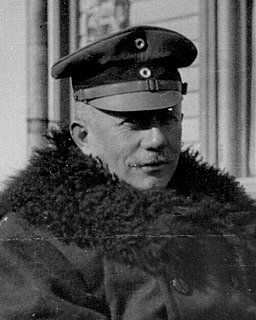
Gustav Adolf Joachim Rüdiger Graf von der Goltz was a German army general during the First World War. He commanded the Baltic Sea Division, which successfully intervened in the Finnish Civil War in the spring of 1918. Goltz stayed with his troops in Finland until December 1918 representing German interests, and in practise ruled the country as a military dictator during this period. After the Armistice of 11 November 1918, Goltz commanded the army of the Baltic German-established Government of Latvia, which in 1919 was instrumental in the defeat of the Russian Bolsheviks and their local allies in Latvia, but suffered a defeat against Estonia and was eventually unsuccessful in retaining German control over the Baltic region after the War.

The Latvian War of Independence, sometimes called Latvia's freedom battles or the Latvian War of Liberation, was a series of military conflicts in Latvia between 5 December 1918, after the newly proclaimed Republic of Latvia was invaded by Soviet Russia, and the signing of the Latvian-Soviet Riga Peace Treaty on 11 August 1920.
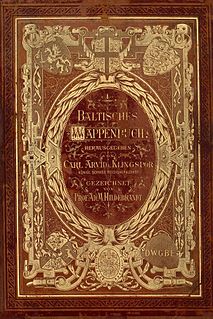
The Baltic or Baltic German nobility was the privileged social class in the territories of today's Estonia and Latvia. It existed continuously since the Northern Crusades and the medieval foundation of Terra Mariana. Most of the nobility were Baltic Germans, but with the changing political landscape over the centuries, Polish, Swedish and Russian families also became part of the nobility, just as Baltic German families re-settled in e.g. the Swedish and Russian Empires. The nobility of Lithuania is for historical, social and ethnic reasons often separated from the German-dominated nobility of Estonia and Latvia.

After 1918, the term Freikorps was used for the anti-communist paramilitary organizations that sprang up around the German Empire, including in the Baltic states, as soldiers returned in defeat from World War I. It was one of the many Weimar paramilitary groups active during that time.

The Baltic Landwehr or Baltische Landeswehr was the name of the unified armed forces of Couronian and Livonian nobility from 7 December 1918 to 3 July 1919.
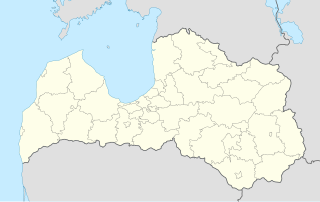
The Battle of Cēsis, fought near Cēsis in June 1919, was a decisive battle in the Estonian War of Independence and the Latvian War of Independence. After heavy fighting an Estonian force moving from the north, supplemented by Latvian units, repelled Baltic German attacks and went on full counter-attack.

Anatol Leonid Fürst von Lieven, was a Baltic German prince of the Lieven family who commanded a counter-revolutionary White movement during the Russian Civil War in Latvia known after him as the Liventsy.

The Clasp to the Iron Cross was a white metal medal clasp displayed on the uniforms of German Wehrmacht personnel who had been awarded the Iron Cross in World War I, and who again qualified for the decoration in World War II.
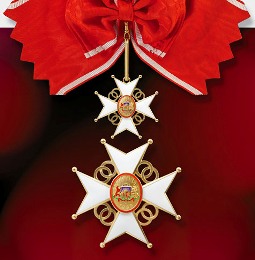
The Cross of Recognition is a state decoration of Latvia.

The Latvian Provisional Government was formed on November 18, 1918 by the People's Council of Latvia as the interim government of the newly-proclaimed Republic of Latvia during the Latvian War of Independence. The term encompasses three cabinets led by Kārlis Ulmanis, the leader of the Agrarian Union, who was chosen to be Prime Minister. The Ulmanis' government led the country until the formation of an elected cabinet after the elections to the Constitutional Assembly of Latvia in June 1920.

The German Knight's Cross was an award of the German Freikorps which existed after the close of the First World War. The award was created in 1919 and was designed by Captain Alfred von Randow. Known alternatively as the "Randow Cross", the decoration was issued mainly to members of the Free Corps formation "Volunteer Detachment von Randow" which had been raised in January 1919 for security in the Baltic region.

The Courland Cuff Title, or Courland Cuff Band, was a World War II German military decoration awarded to Wehrmacht servicemen of Army Group Courland who served in the Courland Pocket.
